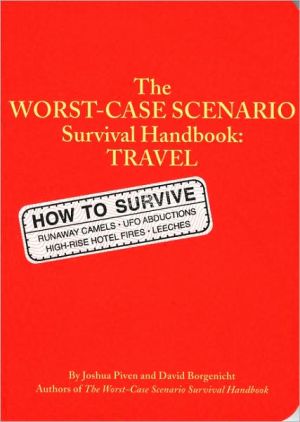The Worst-Case Scenario Travel Handbook
If you have to leave home, TAKE THIS BOOK! The team that brought you The Worst-Case Scenario Survival Handbook now helps you navigate the perils of travel. Learn what to do when the tarantula crawls up your leg, the riptide pulls you out to sea, the sandstorms headed your way, or your camel just wont stop. Find out how to pass a bribe, remove leeches, climb out of a well, survive a fall onto subway tracks, catch a fish without a rod, and preserve a severed limb. Hands-on, step-by-step...
Search in google:
If you have to leave home, TAKE THIS BOOK! The team that brought you The Worst-Case Scenario Survival Handbook now helps you navigate the perils of travel. Learn what to do when the tarantula crawls up your leg, the riptide pulls you out to sea, the sandstorm s headed your way, or your camel just won t stop. Find out how to pass a bribe, remove leeches, climb out of a well, survive a fall onto subway tracks, catch a fish without a rod, and preserve a severed limb. Hands-on, step-by-step instructions show you how to survive these and dozens of other adventures. An appendix of travel tips, useful phrases, and gestures to avoid will also ensure your safe return. Because you just never know... Publishers Weekly Just in time for summer travel, the hyperimaginative and slightly paranoid authors of The Worst-Case Scenario Survival Handbook, 1999's favorite gift book, deliver what will no doubt become popular airport reading for stranded passengers in 2001. Starting with the cheery statistic that "more than 50 percent of all travelers run into problems," and the basic advisory to "always be ready for the worst," the book presents concise and extremely knowledgeable "how-to" assistance on a range of topics: e.g., stopping a runaway train, surviving a hostage situation, escaping from a car hanging over the edge of a cliff, surviving in a plummeting elevator, navigating a minefield, crossing a piranha-infested river, treating a severed limb, removing a leech and even foiling a UFO abduction. Like their earlier handbook, the success of each entry is based on the authors' ability to provide detailed and truly helpful advice on even the most outlandish or horrific situation and make the reader think, "Sure, I could successfully crash-land a small propeller plane on water, or easily climb out of a deep well, or locate and treat individual bleeding arteries on the stump of a severed arm. Nothing to it!" Their delivery evinces a calm precision that even the most worried traveler will find reassuring if faced with one or more of these eventualities, such as trying to escape when tied up ("When your captives start binding you, expand your body as much as possible") or encountering an extraterrestrial biological entity (EBE), unlikely as that might be: "Firmly tell the EBE to leave you alone... Go for the EBE's eyes (if they have any) you will not know what its other, more sensitive, areas are." Although some appendixes on strategies for packing, etc., seem boilerplate, overall this is another eminently practical, enjoyable survival guide. Watch out for those tsunamis! Illus. (May) Forecast: The Worst Case Scenario Survival Handbook was a runaway bestseller. This will be, too. Copyright 2001 Cahners Business Information.
\ \ \ \ \ Chapter One\ HOW TO CONTROL A RUNAWAY CAMEL\ \ \ [1] Hang on to the reins—but do not pull them back hard in an attempt to stop the camel.\ A camel's head, unlike that of a wayward horse, cannot always be pulled to the side to slow it down. Camels are usually harnessed with a head halter or nose reins, and pulling on the nose reins can tear the camel's nose—or break the reins.\ \ \ [2] If the camel has sturdy reins and a head halter, pull the reins to one side to make the camel run in a circle.\ Do not fight the camel; pull the reins in the direction the camel attempts to turn its head. The camel may change direction several times during the incident—let it do so.\ \ \ [3] If the camel has nose reins, just hang on tight.\ Use the reins for balance, and grip with your legs. If there is a saddle, hold on to the horn.\ \ \ [4] Hold on until the camel stops.\ Whether the camel is running in circles or in a straight path, it will not run very far. The camel will sit down when it grows tired.\ \ \ [5] When the camel sits, jump off.\ Hold on to the reins to keep it from running off.\ \ \ HOW TO STOP A RUNAWAY PASSENGER TRAIN\ \ \ [1] Locate the emergency brake.\ There is an emergency brake valve just inside each end of every passenger car. These valves are generally red and should be clearly marked.\ \ \ [2] Pull the handle.\ This opens a valve that vents brake pipe air pressure to the atmosphere, applying the brakes for an emergency stop. There is a possibility of derailment, depending upon track curvature and grade, trainweight, and the number of coaches.\ \ \ If the Brake Does Not Work\ \ \ [1] Call for help.\ Locate a crew member's radio. Depress the "talk" button between the earpiece and the microphone. Do not change the channel, even if you do not hear an answer. Transmit an emergency distress call: Give any information that may help the listener understand the location of the train (for example, train number and destination). The Train Dispatcher should hear you and may clear traffic without responding. If you cannot find anyone on the radio, you will have to attempt to stop the train yourself.\ \ \ [2] Make your way to the front of the train.\ Pull all emergency brake valves as you proceed, or instruct other passengers to apply handbrakes. These brakes are different from the red valves described earlier, and are located on each end of the passenger coach, inside the vestibule. They are applied by turning a wheel or pumping a lever. Tighten these valves as much as possible, and leave them applied.\ \ \ [3] Enter the locomotive.\ The locomotive is usually right after the baggage car, just in front of the passenger coaches. Exercise extreme caution when stepping over and across the car couplers that connect the locomotive and baggage car.\ \ \ There may be several locomotives on the train—not just one. Repeat the following steps in each locomotive. However, there is a chance that the trailing locomotive cab will be reversed, and that you will not be able to proceed any farther forward. If this is the case, retreat to the last car of the train and follow the instructions on page 26: "If the Train is Not Slowing or a Crash is Imminent."\ \ \ [4] Open all emergency valves located in the engine room on or near the dash (at the left side of the cab).\ The emergency valves will be clearly marked. Place the handles in the farthest position forward.\ \ \ [5] Move all levers and handles forward, toward the windshield.\ Be certain to move the brake valves forward (they will have the word "brake" at the base of the handles). Quickly push or move down all white sliding switches on and around the control stand to shut off electricity to the engine(s).\ \ \ [6] If the train is still not slowing down, enter the engine room, which will be behind you to your right.\ A very loud engine room will indicate that the locomotive is "under load," or still operating.\ \ \ [7] Move rapidly through the engine room, along the engine block.\ The engine block stands about four or five feet tall and looks like a large automobile engine.\ \ \ [8] Shut down the engine by pulling the layshaft lever.\ This is a two-foot-long handle at shoulder height near the end of the engine block. It may be difficult to find, as it is not painted a different color from the engine itself. Push the handle all the way in, and the engine will run too fast and shut down. This lever is mechanical and will shut down the engine without fail.\ \ \ [9] Return to the cab and sound the whistle to warn others of your approach—it may take several miles to stop the train completely.\ The whistle is either a handle the size of your hand that points upward, or a button located on the control panel marked "horn."\ \ \ If the Train Is Not Slowing or a Crash Is Imminent\ \ \ [1] Proceed as calmly and quietly as possible to the rear of the train.\ This is the safest place to be in the event of a crash. Instruct the other passengers to move to the back of the train with you.\ \ \ [2] Prepare for a crash.\ Sleeping cars are usually placed on the tail end of the train and have mattresses and pillows that can be used for protection. Sit or lay against a wall that is toward the leading end of the train, so you will not fly forward in the event of a crash. The farther you are from the locomotive the better.\ \ \ HOW TO STOP A CAR WITH NO BRAKES\ \ \ [1] Begin pumping the brake pedal and keep pumping it.\ You may be able to build up enough pressure in the braking system to slow down a bit, or even stop completely. If you have anti-lock brakes, you do not normally pump them—but if your brakes have failed, this may work.\ \ \ [2] Do not panic—relax and steer the car smoothly.\ Cars will often safely corner at speeds much higher than you realize or are used to driving. The rear of the car may slip; steer evenly, being careful not to overcorrect.\ \ \ [3] Shift the car into the lowest gear possible and let the engine and transmission slow you down.\ \ \ [4] Pull the emergency brake—but not too hard.\ Pulling too hard on the emergency brake will cause the rear wheels to lock, and the car to spin around. Use even, constant pressure. In most cars, the emergency brake (also known as the hand brake or parking brake) is cable operated and serves as a fail-safe brake that should still work even when the rest of the braking system has failed. The car should slow down and, in combination with the lower gear, will eventually stop.\ \ \ [5] If you are running out of room, try a "bootlegger's turn."\ Yank the emergency brake hard while turning the wheel a quarter turn in either direction—whichever is safer. This will make the car spin 180 degrees. If you were heading downhill, this spin will head you back uphill, allowing you to slow down.\ \ \ [6] If you have room, swerve the car back and forth across the road.\ Making hard turns at each side of the road will decrease your speed even more.\ \ \ [7] If you come up behind another car, use it to help you stop.\ Blow your horn, flash your lights, and try to get the driver's attention. If you hit the car, be sure to hit it square, bumper to bumper, so you do not knock the other car off the road. This is an extremely dangerous maneuver: It works best if the vehicle in front of you is larger than yours—a bus or truck is ideal—and if both vehicles are traveling at similar speeds. You do not want to crash into a much slower-moving or stopped vehicle, however.\ \ \ [8] Look for something to help stop you.\ A flat or uphill road that intersects with the road you are on, a field, or a fence will slow you further but not stop you suddenly. Scraping the side of your car against a guardrail is another option. Avoid trees and wooden telephone poles: They do not yield as readily.\ \ \ [9] Do not attempt to sideswipe oncoming cars.\ \ \ [10] If none of the above steps has enabled you to stop and you are about to go over a cliff, try to hit something that will slow you down before you go over.\ This strategy will also leave a clue to others that someone has gone over the edge. But since very few cliffs are sheer drops, you may fall just several feet and then stop.
Foreword10Introduction161Getting There19How to Control a Runaway Camel20How to Stop a Runaway Passenger Train22How to Stop a Car with No Brakes27How to Stop a Runaway Horse30How to Crash-Land a Plane on Water32How to Survive an Airplane Crash392People Skills43How to Survive a Riot44How to Survive a Hostage Situation49How to Pass a Bribe52How to Foil a Scam Artist54How to Foil a UFO Abduction58How to Survive a Mugging61How to Tail a Thief63How to Lose Someone Who Is Following You653Getting Around69How to Jump from Rooftop to Rooftop70How to Jump from a Moving Train73How to Escape from a Car Hanging over the Edge of a Cliff76How to Escape When Tied Up79How to Ram a Barricade82How to Escape from the Trunk of a Car84How to Survive a Fall onto Subway Tracks86How to Survive in a Plummeting Elevator894Out and About91How to Survive When Lost in the Jungle92How to Find Your Way without a Compass96How to Climb out of a Well99How to Navigate a Minefield104How to Survive a Riptide108How to Survive When You Fall through Ice110How to Survive in Frigid Water112How to Survive a Trip over a Waterfall116How to Survive a Volcanic Eruption1185Food and Shelter121How to Survive a High-Rise Hotel Fire122How to Find Water on a Deserted Island126How to Purify Water129How to Build a Shelter in the Snow132How to Survive a Tsunami136How to Survive a Sandstorm138How to Catch Fish without a Rod140How to Make Animal Traps1426Surviving Illness and Injury147How to Deal with a Tarantula148How to Treat a Scorpion Sting152How to Cross a Piranha-Infested River155How to Treat a Severed Limb157How to Remove a Leech162Appendix166General Travel Strategies167Strategies for packing168Strategies for Flying170Strategies for Hotels172Strategies for Travel in Dangerous Regions173Foreign Emergency Phrases174Gestures to Avoid178About the Experts181About the Authors191
\ From Barnes & NobleThe Barnes & Noble Review\ Armchair travelers and adventure travelers alike will get a kick out of The Worst-Case Scenario Travel Handbook, the companion volume to Joshua Piven and David Borgenicht's runaway bestseller, The Worst-Case Scenario Survival Handbook. Learn vital travel skills, such as how to stop a runaway camel, how to cross a piranha-infested river, and how to foil a UFO abduction, in this entertaining and -- believe it or not -- useful guide. \ Most travelers won't need to know how to remove leeches, survive a sandstorm, or treat a scorpion sting, but thanks to hardcore adventure travel guides, such as Robert Young Pelton's bestseller The World's Most Dangerous Places, there are more and more "danger tourists" willing to risk their lives for a once-in-a-lifetime experience. If that's your cup of tea, then you should definitely pack The Worst-Case Scenario Travel Handbook. The book's potentially lifesaving advice comes exclusively from experts who have extensive medical or scientific training or years of field experience with the deadly creatures, natural disasters, or hostile terrorists mentioned in the book. For example, the section explaining how to escape when tied up was written by "The Amazing Flanagan," a magician and escape artist. Who else would you trust for that information? The instructions for treating a severed limb were contributed by a Harvard Medical School physician, and the notes on how to stop a car with no brakes come from a demolition derby driver.\ Whether or not you're planning to travel into regions where life-threatening situations involving sandstorms, tsunami, or tarantulas are common, fate could throw you a curve ball at any moment. Be prepared with The Worst-Case Scenario Travel Handbook -- that runaway train or volcanic eruption might be right around the corner. (Julie Carr)\ \ \ \ \ \ From the PublisherPEOPLE Quick: You're on an elevator when the cable snaps, plunging you into free fall. What do you do? Jump in the air at the moment of impact, right? Sure, except that the elevator "will likely collapse... and crush you," note the authors of the bestseller The Worst-Case Scenario Survival Handbook. The right answer: Lie flat on the floor to distribute the impact. In deadpan tone, Piven and Borgenicht advise how to survive a plane crash, remove a leech (burning it off will make it regurgitate, causing infection who knew?) and escape from the trunk of a car. The scenarios owe a debt to action flick cliches how often do you find yourself leaping from rooftop to rooftop? but their utter implausibility doesn't make this read any less riveting.\ \ \ \ Publishers WeeklyJust in time for summer travel, the hyperimaginative and slightly paranoid authors of The Worst-Case Scenario Survival Handbook, 1999's favorite gift book, deliver what will no doubt become popular airport reading for stranded passengers in 2001. Starting with the cheery statistic that "more than 50 percent of all travelers run into problems," and the basic advisory to "always be ready for the worst," the book presents concise and extremely knowledgeable "how-to" assistance on a range of topics: e.g., stopping a runaway train, surviving a hostage situation, escaping from a car hanging over the edge of a cliff, surviving in a plummeting elevator, navigating a minefield, crossing a piranha-infested river, treating a severed limb, removing a leech and even foiling a UFO abduction. Like their earlier handbook, the success of each entry is based on the authors' ability to provide detailed and truly helpful advice on even the most outlandish or horrific situation and make the reader think, "Sure, I could successfully crash-land a small propeller plane on water, or easily climb out of a deep well, or locate and treat individual bleeding arteries on the stump of a severed arm. Nothing to it!" Their delivery evinces a calm precision that even the most worried traveler will find reassuring if faced with one or more of these eventualities, such as trying to escape when tied up ("When your captives start binding you, expand your body as much as possible") or encountering an extraterrestrial biological entity (EBE), unlikely as that might be: "Firmly tell the EBE to leave you alone... Go for the EBE's eyes (if they have any) you will not know what its other, more sensitive, areas are." Although some appendixes on strategies for packing, etc., seem boilerplate, overall this is another eminently practical, enjoyable survival guide. Watch out for those tsunamis! Illus. (May) Forecast: The Worst Case Scenario Survival Handbook was a runaway bestseller. This will be, too. Copyright 2001 Cahners Business Information.\ \








